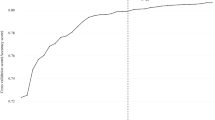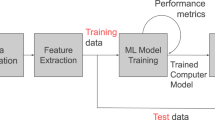Abstract
Based on the 2016 Progress in International Reading Literacy Research (PIRLS) data, this study determined the contextual characteristics that distinguished Moroccan fourth-grade kids with high- and low-achieving reading abilities. The PIRLS 2016 public dataset included 5446 Moroccan pupils, with 1545 scoring well and 3901 doing poorly on the reading portion of the exam. The objective of the present research was to determine the ideal combination of significant contextual elements that jointly affect fourth-grade children’s reading ability. Machine learning technique such as gradient boosting was used to find the most critical contextual variables that might distinguish between the two groups of students. The findings demonstrate that 12 significant contextual variables from GradientBoosting, selected from 486 contextual variables at the levels of the student, teacher, and school, Identifying high- and low-performing students collectively have consequences for teaching and learning in the future about the reading ability of primary school students.


















Similar content being viewed by others
Availability of data and materials
The data used this study are available from https://timssandpirls.bc.edu/pirls2016/international-database/index.html
Code availability
The code that support the findings of this study are available from the corresponding author upon reasonable request.
References
Aler, R., Galván, I.M., Ruiz-Arias, J.A., Gueymard C.A. (2017). Improving the separation of direct and diffuse solar radiation components using machine learning by gradient boosting. Solar Energy, 150, 558–569.
Aram, D. , Levin, I. (2002). Mother–child joint writing and storybook reading: Relations with literacy among low ses kindergartners. Merrill-Palmer Quarterly (1982-), 202–224.
Areepattamannil, S., Freeman, J.G., Klinger, D.A. (2011). Influence of motivation, self-beliefs, and instructional practices on science achievement of adolescents in canada. Social Psychology of Education. 14(2), 233–259.
Berninger, V. W., Nielsen, K. H., Abbott, R. D., Wijsman, E., Raskind, W. (2008). Gender differences in severity of writing and reading disabilities. Journal of school psychology. 46(2), 151–172.
Berrar, D. (2019). Cross-Validation.
Breiman, L. (2001). Random forests. Machine learning. 45(1), 5–32.
Burman, D. D., Bitan, T., Booth, J. R. (2008). Sex differences in neural processing of language among children. Neuropsychologia. 46(5), 1349–1362.
Carlisle, J. F., Correnti, R., Phelps, G., Zeng, J. (2009). Exploration of the contribution of teachers’ knowledge about reading to their students’ improvement in reading. Reading and Writing. 22(4), 457–486.
Chen, J., Zhang, Y., Hu, J. (2021). Synergistic effects of instruction and affect factors on high-and low-ability disparities in elementary students’ reading literacy. Reading and Writing. 34(1), 199–230.
Cichosz, P. (2015). Classification model evaluation.
Cordero, J. M., Santín, D., Simancas, R. (2017). Assessing european primary school performance through a conditional nonparametric model. Journal of the Operational Research Society. 68(4), 364–376.
Creemers, B., Kyriakides, L. (2010). School factors explaining achievement on cognitive and affective outcomes: Establishing a dynamic model of educational effectiveness. Scandinavian Journal of Educational Research. 54(3), 263–294.
Epstein, J. L. (2018). School, family, and community partnerships: Preparing educators and improving schools. Routledge.
Farver, J. A. M., Xu, Y., Eppe, S., Lonigan, C. J. (2006). Home environments and young latino children’s school readiness. Early Childhood Research Quarterly. 21(2), 196–212.
Giambona, F., Porcu, M. (2018). School size and students’ achievement. empirical evidences from pisa survey data. Socio-Economic Planning Sciences. 64, 66–77.
Gnaldi, M., Schagen, I., Twist, L., Morrison, J. (2005). Attitude items and low ability students: The need for a cautious approach to interpretation. Educational Studies. 31(2), 103–113.
Gregorutti, B., Michel, B., Saint-Pierre, P. (2017). Correlation and variable importance in random forests. Statistics and Computing. 27(3), 659–678.
Gustafsson, J. E., Balke, G. (1993). General and specific abilities as predictors of school achievement. Multivariate behavioral research. 28(4), 407–434.
Hearst, M. A., Dumais, S. T., Osuna, E., Platt, J., Scholkopf, B. (1998). Support vector machines. IEEE Intelligent Systems and their applications. 13(4), 18–28.
Hosmer Jr, D. W. , Lemeshow, S. ,Sturdivant, R. X. (2013). Applied logistic regression (Vol. 398). John Wiley & Sons.
Hu, J. (2014). An analysis of the design process of a language learning management system. Control and Intelligent Systems. 42(1), 80–86.
Huljanah, M. , Rustam, Z. , Utama, S. , Siswantining, T. (2019). Feature selection using random forest classifier for predicting prostate cancer. Iop conference series: Materials science and engineering (Vol. 546, p. 052031).
Jehangir, K., Glas, C. A., van den Berg, S. (2015). Exploring the relation between socio-economic status and reading achievement in pisa 2009 through an intercepts-and-slopes-as-outcomes paradigm. International Journal of Educational Research. 71, 1–15.
Jiang, S., Pang, G., Wu, M., Kuang, L. (2012). An improved k-nearest-neighbor algorithm for text categorization. Expert Systems with Applications. 39(1), 1503–1509.
Jing, Y., Li, B., Chen, N., Li, X., Hu, J., Zhu, F. et al. (2015). The discrimination of learning styles by bayes-based statistics: An extended study on ils system. Control and Intelligent Systems. 43(2), 68–75.
John, G. , Langley, P. (1995). Estimating continuous distributions in bayesian classifiers. in proceedings of the eleventh conference on uncertainty in artificial intelligence. Morgan Kaufmann Publishers Inc. 338–345.
Law, Y. K. (2009). The role of attribution beliefs, motivation and strategy use in chinese fifth-graders’ reading comprehension. Educational research. 51(1), 77–95.
Lee, V. E., Burkam, D. T. (2003). Dropping out of high school: The role of school organization and structure. American educational research journal. 40(2), 353–393.
Li, B. , Yu, S. , Lu, Q. (2003). An improved k-nearest neighbor algorithm for text categorization. arXiv preprint cs/0306099.
Lyaqini, S., Nachaoui, M., Hadri, A. (2022). An efficient primal-dual method for solving non-smooth machine learning problem. Chaos, Solitons & Fractals. 155, 111754.
Machin, S., McNally, S., Wyness, G. (2013). Educational attainment across the uk nations: performance, inequality and evidence. Educational Research. 55(2), 139–164.
Marzban, C. (2004). The roc curve and the area under it as performance measures. Weather and Forecasting. 19(6), 1106–1114.
Mullis, I. V. , Kennedy, A. M. , Martin, M. O. , Sainsbury, M. (2004). Pirls 2006 assessment framework and specifications: Progress in international reading literacy study. ERIC.
Mullis, I. V. , Martin, M. O. , Foy, P. , Arora, A. (2020). Timss 2019 international results in mathematics. ERIC.
Mullis, I. V. , Martin, M. O. , Foy, P. , Drucker, K. T. (2012). Pirls 2011 international results in reading. ERIC.
Mullis, I. V. , Martin, M. O. , Foy, P. , Hooper, M. (2017). epirls 2016: International results in online informational reading. International Association for the Evaluation of Educational Achievement.
Mullis, I. V. , Martin, M. O. , Gonzalez, E. J. , Chrostowski, S. J. (2004). Timss 2003 international mathematics report: Findings from iea’s trends in international mathematics and science study at the fourth and eighth grades. ERIC.
Mursalin, M., Zhang, Y., Chen, Y., Chawla, N. V. (2017). Automated epileptic seizure detection using improved correlation-based feature selection with random forest classifier. Neurocomputing. 241, 204–214.
Nachaoui, M., Lyaqini, S., Chaouch, M. (2023). Indicating if water is safe for human consumption using an enhanced machine learning approach. Statistics, Optimization & Information Computing. 11(1), 70–81.
Ngorosho, D. (2011). Reading and writing ability in relation to home environment: A study in primary education in rural tanzania. Child Indicators Research. 4(3), 369–388.
Park, Y. (2011). How motivational constructs interact to predict elementary students’ reading performance: Examples from attitudes and self-concept in reading. Learning and Individual Differences. 21(4), 347–358.
Rokach, L. (2005). Data mining and knowledge discovery handbook. Springer Science+ Business Media, Incorporated.
Rutter, M., Maughan, B. (2002). School effectiveness findings 1979–2002. Journal of school psychology. 40(6), 451–475.
Schneider, S. L. (2013). The international standard classification of education 2011. Class and stratification analysis. Emerald Group Publishing Limited.
Shultz, T. R., Fahlman, S. E., Craw, S., Andritsos, P., Tsaparas, P., Silva, R., ... others (2011). Confusion matrix. Encyclopedia of machine learning. 61(8), 209–209.
Tang, J., Alelyani, S., Liu, H. (2014). Feature selection for classification: A review. Data classification: Algorithms and applications. 37.
Tramonte, L., Willms, J. D. (2010). Cultural capital and its effects on education outcomes. Economics of Education Review. 29(2), 200–213.
Tse, S. K., Xiao, X. Y. (2014). Differential influences of affective factors and contextual factors on high-proficiency readers and low-proficiency readers: A multilevel analysis of pirls data from hong kong. Large-scale Assessments in Education. 2(1), 1–24.
Wei, Y., Hu, J. (2020). Differentiating critical thinking dispositions of newly enrolled efl undergraduates and postgraduates through svm approach. Mechatronic Systems and Control. 48, 159–164.
Zhang, H. (2004). The optimality of naive bayes. Aa. 1(2), 3.
Funding
Not applicable.
Author information
Authors and Affiliations
Contributions
Not applicable.
Corresponding author
Ethics declarations
Ethics approval
Not applicable.
Consent to participate
Not applicable.
Consent for publication
Not applicable.
Conflict of interest
The authors declare that they have no confict of interest.
Rights and permissions
Springer Nature or its licensor (e.g. a society or other partner) holds exclusive rights to this article under a publishing agreement with the author(s) or other rightsholder(s); author self-archiving of the accepted manuscript version of this article is solely governed by the terms of such publishing agreement and applicable law.
About this article
Cite this article
Khoudi, Z., Nachaoui, M. & Lyaqini, S. Identifying the contextual factors related to the reading performance of Moroccan fourth-grade students from a Machine Learning-based Approach.. Educ Inf Technol 29, 3047–3073 (2024). https://doi.org/10.1007/s10639-023-11881-8
Received:
Accepted:
Published:
Issue Date:
DOI: https://doi.org/10.1007/s10639-023-11881-8




